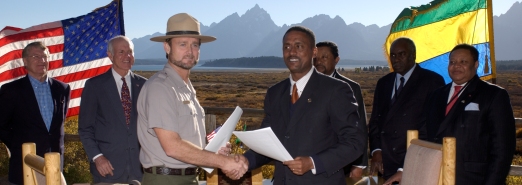



The National Park Service conducts international technical assistance projects around the globe. For information on what the service is conducting in specific countries, visit the Around the World page.
Every year several hundred foreign professional park and conservation leaders are received by the National Park Service. They come for many reasons: formal training through in-service courses, professional conferences with NPS personnel, direct observation of park administration and operations, interviews with park staff, practical internships through assignments at NPS sites, and orientation to the general range of the National Park Service’s work as a basis for negotiation of cooperative international projects in which the Park Service will be involved.
For the professional park officials in other countries, the National Park Service's image is one of excellence and its professional capabilities and years of experience are more extensive and varied than almost any other park management organization in the world. Foreign dignitaries request briefings and interviews with National Park Service personnel. They are often cabinet-level officials and promising young leaders in politics, economics, and education whose impressions can form lasting personal commitments to heritage conservation/park system objectives in their own countries.
Sharing expertise with visiting park and conservation professionals, in addition to the National Park Service’s overseas technical missions, demonstrates the full-range commitment of the Park Service in its contributions to global environmental conservation. The National Park Service's most successful exchange products and programs have been park planning assistance; program evaluation assistance; international training programs, including interpretive skills training; and conferences, workshops, and symposia. Additionally, the Park Service has a strong International Volunteer in the Parks program that enables current and future park professionals from other countries to volunteer their services to individual park units within the U.S.
A few examples of the National Park Service’s international activities include the following:
· In China, a direct link was formed with the authorities of the Sichuan Province, which retains many of the increasingly rare wilderness features of ancient China and the only habitat for the Panda, one of the most endangered animals in the world. Service staff worked with its Chinese counterparts to develop a management plan for the Jiuzhaigou Nature Reserve, critical Panda habitat.
· National Park Service researchers have obtained nearly 40,000 historical documents from Spanish archival research with the active assistance of the Spanish government. These documents enhance the Park Service’s understanding of Spanish heritage properties in the U.S. system and its interpretation of these cultural resources.
· Russians have directly assisted the National Park Service with the restoration and furnishing the Russian Bishop’s house at Sitka, Alaska.
· In India, the National Park Service provided site planning expertise for the Taj Mahal, and archeological and pilgrimage sites connected with the life of the Buddha.
Congress and and successive administrations have indicated that investments in U.S. national parks for preservation of wildlife values are incomplete unless we also invest in assuring that critical habitat is effectively protected in other countries to, and from, which the wildlife migrates. For example, money and time invested in training park rangers in Mexico, Central America, and the Caribbean are an investment to assure the preservation of park wildlife in NPS sites such as Everglades NP. The international mission statement adopted by the Park Service implies strong initiatives with our border nations. As a result, the Service cooperates with all of the U.S. border neighbors, including the Caribbean nations, Mexico, Canada, and the Russian Federation.
The types of technical assistance requests from park and conservation professionals and officials in other countries change continuously. Current requests to the Park Service include assistance for: ecosystem management; economically and environmentally sustainable parks and facilities; "ecotourism"; cultural heritage; "planning beyond park boundaries"---community relations and planning development adjacent to parks; partnership development with non-government organizations and private volunteer organizations; technologically sophisticated scientific and management techniques including Geographic Information Systems, Global Positioning Systems, and computer-aided design of interpretive materials; international tourism; and concessions’ management.
Guiding Principles for NPS International Technical Assistance
Summary of the National Park Service's legal authority to conduct programs for technical exchange and cooperation with other countries.